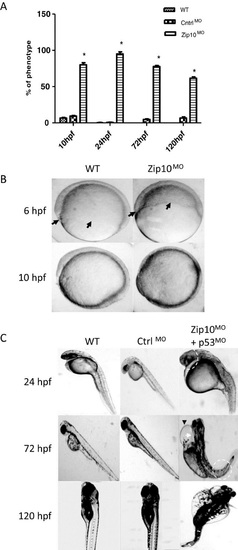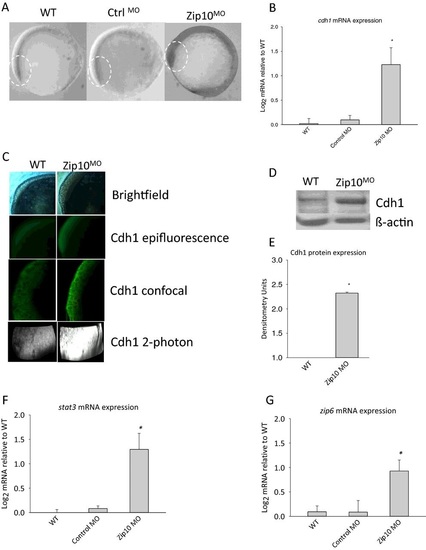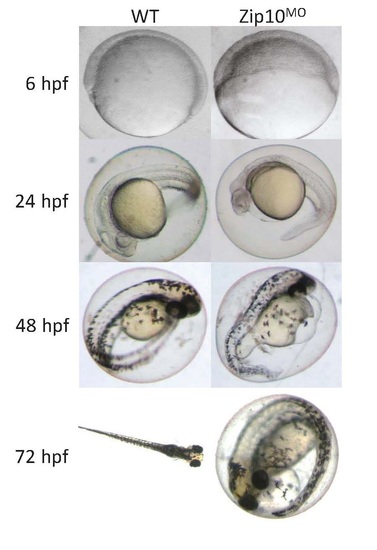- Title
-
Zinc transporter ZIP10 forms a heteromer with ZIP6 which regulates embryonic development and cell migration
- Authors
- Taylor, K.M., Muraina, I., Brethour, D., Schmitt-Ulms, G., Nimmanon, T., Ziliotto, S., Kille, P., Hogstrand, C.
- Source
- Full text @ Biochem. J.
|
Phenotype of Zip10 knockdown zebrafish embryo Zebrafish embryos were co-injected with 2 ng of translation blocking morpholino-modified oligonucleotides against zip10 and p53 (to block off-target effects causing apoptosis; Zip10MO) or with 2 ng of a scrambled control morpholino (CtrlMO) and compared with uninjected wild-type (WT) embryos. (A) Percentage of embryos displaying morbidities (% phenotypes) at 10, 24, 72 and 120 hpf. (B) Epiboly cell migration in wild-type embryos and in embryos injected with a translation blocking morpholino against zip10 (Zip10MO) or with a scrambled control morpholino (CntrlMO). The extension of epipoly migration was delayed in Zip10MO embryos compared with time-matched controls (arrows) at 6 and 10 hpf with resulting delay in tail bud formation in morphants at 10 hpf compared with wild type. Morphant was yet to complete epiboly (85% complete) at 10 hpf when tail bud has already formed in wild type. (C) Common phenotypes of Zip10MO embryos at later stages of development (24-120 hpf). Note the Zip10MO embryo at 24 hpf with shorter anterior-posterior axis with abnormal head and eye formation (highlighted with white broken circle). Also note the oedema of the pericardial sac (black arrow-head) and the miss-formed heart (heart-string) feature (white arrow) in 72 hpf Zip10MO embryos. Severe oedema of pericardium and yolk sac was observed in many embryos at 120 hpf. Note also the curled or twisted tail at 72 and 120 hpf (white broken circles). The experiment was carried out five times with 20-50 embryos each time (N=5). Results were also replicated using a splicing blocking morpholino against zip10 (results not shown). |
|
Effect of Zip10 knockdown on expression of genes involved in EMT during gastrulation of the zebrafish embryo 10 hpf (A) ISH of E-cadherin (cdh1) mRNA in zebrafish wild-type embryos (WT), control embryos injected with a scrambled morpholino (CtrlMO), and in embryos injected at 1-4 cell stage with a translation blocking morpholino against zip10 (Zip10MO) at 10 hpf. Ten embryos from each group were assessed and the experiment was repeated with the same results. (B) Expression of cdh1 mRNA in WT, CnrtlMO and Zip10MO zebrafish embryos as measured by qPCR. Data are presented as the mean±S.E.M. (N=6 and the experiment was repeated with the same results). (C) Expression of Cdh1 protein during epipoly in WT and Zip10MO embryos as assessed by immunohistochemistry (N=3) or (D) by immunoblots, which were (E) quantified by band intensity (mean±S.E.M., N=3). qPCR analysis of mRNA for the gastrulation-inducing gene products of (F) stat3 and (G) zip6. Data are expressed as log2 fold change and error bars represent mean±S.E.M. (N=6 and the experiment was repeated with the same results). Data were statistically evaluated by ANOVA and significant differences (P<0.05) relative to the WT indicated by an asterisk. |
|
Phenotype of Zip10MO zebrafish. Zebrafish embryos were injected with 2 ng of translation blocking morpholino-modified oligonucleotides against zip10 and compared to uninjected wild type (WT) embryos. Morphological defects observed from 6 to 72 hpf included delayed epiboly, underdeveloped and deformed head, brain and eyes, stunted body axis, bent or curled tail, oedema of the pericardial sack, deformed heart (heart-string), delayed hatching and reduced hatching success. Other details as in Figure 4. PHENOTYPE:
|

ZFIN is incorporating published figure images and captions as part of an ongoing project. Figures from some publications have not yet been curated, or are not available for display because of copyright restrictions. |



